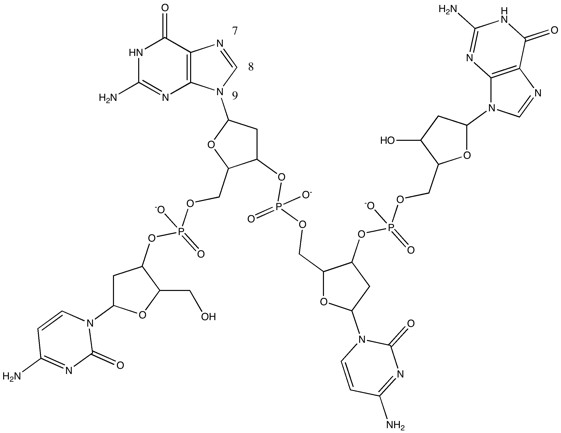In his famous lecture in 1959, C. P. Snow wrote about the breakdown in communications between the “two cultures” of modern society — the sciences and the humanities (arts). That was then. This is now, and the occasion of my visit to a spectacular “city of arts and sciences complex” in Europe. An un-missable exhibit representing science and life was the 15m high model of DNA. Now to be fair this is styled an artist’s impression, and one presumes that an artist is allowed license. But how much license? And at how much expense to the science? And is there a counterbalance to the art where the science is fastidiously (but artistically) preserved?

Let us start from the scientific end of this story, and try a mapping between the two representations. Below is a chemical diagram of one strand of the DNA duplex, showing two cytosines (the single 6-ring base) and two guanines (the 5+6 ring base) joined by a 5-ring ribofuranose to phosphates.

A scientific interpretation of DNA. Click for 3D model (of left handed duplex DNA!)
One more detail. These “rungs” joining the duplex have been rotated by 90° so that the planes of the bases are parallel to the helical axis, rather than perpendicular. How did the artist manage to construct his model in this orientation? Well, probably because he had been given a template similar to the (2D) structure diagram I showed above. A chemist would immediately “see” what is implicit in that diagram, which is all the C-H bonds. Chemists tend to miss these out, because they can be cluttered. But the hydrogen atoms are there, and they do occupy space. In the 3D model, they are still missing. If you imagine their positions in that model, you will immediately spot a number of locations where two hydrogen atoms are trying to occupy almost the same position in space! Of course, were you to rotate the sugar-base-base-sugar rungs by 90° this would create space for these invisible hydrogens.
So what about this breakdown in communication between the scientist and the artist? The latter has attempted two effects. One is to remove unnecessary detail so that one can directly go to the essentials. The other is to “move” the various components around so that they achieve greater “artistic effect”, but with a resulting substantial loss of scientific accuracy. I happen to believe that the model would have looked equally attractive if these scientific liberties had not been taken (perhaps even better!). Perhaps, as I suggest above, the artistic interpretation should be accompanied by a scientific one, to allow the visitor to the museum to see both? Or the communication between sculptor and scientist improved?
Well, I console myself with the observation that at least the artist represents a right rather than a left handed helix!
Tags: artist, chemical diagram, chemist, DNA duplex, duplex DNA, Europe, Historical, scientist and the artist, sculptor and scientist
A scientifically “fastidious” observation as a postscript. If you take a look at this slide from a talk I gave recently, you will observe that (apart from the X-ray diffraction data) Watson and Crick relied very much on avoiding close “van der Waals” contacts in building their model. Indeed, H…H contacts of less than 2.1Å are clearly deprecated. This single key aspect of their model lies at the core of the “science”, and it is precisely this aspect that is artistically ignored in the sculpture shown above.
Regarding the orientation of the bases, note how WC discuss Furberg’s analysis, concluding that the bases are perpendicular to the sugar ring (and hence also perpendicular to the helical axis). Again, this very specific scientific point, crucial to the WC model, is ignored in the sculpture.